CHAPTER 7
CHOOSING YOUR PERFORMANCE METRICS
“It's important that the musicians are on time next week for the fundraiser,” said Sam.
“Yeah, about that, I'm having some trouble finding people to come,” I replied.
“What? It's only a week away.”
My stomach sank. I had been dreading this conversation.
“You did tell them they could eat afterward?” added Sam.
“Yes, but …”
“They do understand how important this event is, right? If the musicians want a raise, then we need the donors to give.”
I had practiced in my head what I was going to say. I didn't want to have another tirade as I had with the board a few months ago. I took a couple of breaths.
“Are the waitstaff going to be paid? Bartenders? Are you paying for the food and drink?”
“We have donors and sponsors covering those things,” Sam replied with a little irritation.
“But the waitstaff, cooks, and other people are not working for free,” I replied.
“No, but that's different. They don't work for the symphony. That's how they make a living,” said Sam.
I just looked at him without saying anything. I let his last words hang in the air rather than immediately responding, hoping he would consider what he was saying.
He sighed. He got it.
“It doesn't make sense for me to tell the players they are working for a raise while at the same time asking them to play for free.”
“You're right,” said Sam. “It's just the way we've done things in the past.”
“It is a new day, Sam,” I replied. “I believe you would have more loyalty and have more accomplished players wanting to play for the symphony if we had the reputation of taking care of our players.”
“I suppose I could ask the Smiths to sponsor the musicians,” Sam said. “They love seeing their names on things to show their friends. They didn't donate anything for auction, so I can leverage that.”
I told Sam how much I needed to pay the musicians.
“That sounds reasonable,” he said.
“Great. I can have the Clayton Quartet play. They said they were available.”
“Wait, you already had them set up for the event?” Sam squinted at me.
“Of course, and I told them to pencil it in. If I couldn't get them any money, I wasn't going to ask them to play.”
“Wow, Jerry, you have become ruthless,” Sam chuckled.
“No, not ruthless. I'm looking after the musicians, who are the greatest asset to this organization. Without them, there would be no symphony. As a musician, I have felt a bit marginalized over the years. I want the musicians to know they are appreciated and will be paid what they are worth.”
“I understand. No worries, mate,” said Sam. “And you're right. I really appreciate you representing them. I believe some people on the board don't quite understand the hard work the musicians put in.”
“It's not only the time and effort; our instruments are expensive. I could be riding in a nice Benz for what one of my basses cost.”
Sam's brows went up. “Really?”
“Yes, really, and I don't have the most expensive instrument in the orchestra.”
“I had no idea,” said Sam.
“Well, I appreciate your support and understanding in this,” I said.
I left Sam's office feeling good. I was worried I would get more resistance, but I knew that I had to try. Changing the culture of the company and shifting its goals and priorities would be a long process.
* * *
As I entered the door, Laura was sitting at the kitchen table. She had a serious look on her face.
“Hey, everything okay?” I asked.
“We need to talk,” she said. “The kids are at a birthday party at Jackie's house.”
I vaguely remembered that our friend Jackie's son Conner was having a party this week. It had completely slipped my mind.
“Oh, no, did I forget to take them?” I asked as I sat down.
“No, I had it handled, but I thought since they were gone, we could talk.”
I was both hopeful and worried that we could talk about our relationship and how things had been going. We had tried a few sessions of marriage counseling, but Laura wouldn't open up, so we stopped going.
“I want to get right to it, Jerry. Since your accident, it has been really hard on me. We were having a tough time before then, but now it's becoming unbearable.”
“I don't understand,” I said in shock.
“We had a decent life a year ago, and I was hopeful that maybe you would audition for a bigger symphony or maybe start teaching over at one of the universities. We have been barely making it for some time. You promised that if I stayed home, you could pick up the slack, but things have only gotten worse, especially since you took on that new position.”
I didn't want to lose my temper, and I wanted to listen to her, but so far she was saying that everything was my fault.
“I don't know why you're pursuing it like you are. Sure, you are making some more money, but you aren't a businessman; you are a musician. Why couldn't you just stick to that?”
“Do you want me to answer that?” I asked.
“Sure, because for the life of me, I don't understand,” she replied.
“I have spent years, well beyond college years, learning my craft. I am a good bass player. Not a great one, but a really good one. But I am not a one‐dimensional person. I have other interests and skills that I'd like to explore. Not only for the money aspect but because I am enjoying the process.”
“Then why didn't you become a businessperson in college rather than a musician?”
“That is the tricky part. I was interested in business, and that is how I met Dr. Richardson. I took a few of his classes and loved them. The problem was that my music major took up much of my time. It wasn't just the classes – I had rehearsals for multiple ensembles, masterclasses, and lessons. There was little time for anything else. But I do regret not taking more business classes because, even as a musician, they were helpful. I have had to figure out a lot of things the hard way. I'm not the only one. Many musicians struggle, even ones with masters' and PhDs. Not only are the jobs scarce, but we are not taught how to make money or develop any other skills. It's not as easy as walking into a university and getting a tenured position in the music department.”
“But did you even try?” Laura asked.
“Of course, I looked into it. I could give lessons, but I would be making a lot less money than I am now, and that is not a steady income.”
Laura just frowned.
“Listen, the stuff I'm learning about project management could start a whole new career for me. I am learning fast and making a difference.”
“A difference to who? I want a different life, Jerry. One in which I don't have to worry about money and where my husband pays more attention to me.”
“I try to spend time with you, but lately you are gone. Mostly out with your friends,” I countered.
“You just don't understand me. My friends get me. They like to have fun and go do things. You are working all the time.”
I wanted to point out the obvious flaw in her logic. She wanted me to make more money, but she wanted me to work less and be around more.
“I admit, I've been really busy lately. I am trying to learn new skills, but I am building processes, so next year it won't be so difficult.”
“Next year?” Laura scoffed. “How about now?”
I didn't know what to say.
“Then there is your injury. You don't even know if you'll be able to play professionally anymore. You have a master's degree in music. You are a dissertation away from a PhD. You need to concentrate on your future.”
“I already explained the issue. …”
Laura cut me off. “I hate to say this, but your injury … makes you even less fun to be around. I constantly have to do things for you because you can't.
“That's not fair. …”
“And now you've turned our children against me,” she blurted.
“What?”
“Corey has become a mini version of you. All he wants to do is play music. He doesn't have time for me. And Linda … she hates me.”
“She doesn't hate you,” I replied.
“She does. You have turned her against me. She is constantly telling me that I am wrong for arguing with you. She takes your side.”
“I never told her to hate you. I can talk to her. …”
“What, so you can tell her that I'm nagging you?”
“Of course I wouldn't say that,” I offered.
“Jerry, there's no point in arguing about this. I have decided that we need a break until you can get your priorities straight,” Laura said.
It felt like a hard blow to the gut.
“You're leaving?”
“Yes. Jackie said I could stay with her until I found an apartment.”
“But … what about the kids?”
“I'll help you get them to where they need to go, but they should stay here, so their school and life aren't interrupted too much. Besides, they adore you anyway.”
“Can't we talk about this?” I asked.
Laura stood up.
“We have talked about it enough. I've made my mind up. I don't know what this will mean long‐term, but for right now, I feel that it is the best.”
My throat tightened. I was upset and angry, and my heart was torn out all at once.
I continued to sit at the empty table as Laura's car pulled out of the driveway. I was numb. What just happened?
I knew we had troubles, but I didn't think she would want a separation while we were trying to work things out. What was I going to do?
* * *
The next morning, I showed up for coffee with Dr. Richardson. Laura had dropped the kids back home, and after she tucked them in, she left again. In the morning, she arrived before they got up and made breakfast, and got them off to school. She said nothing as she got into her car and left again.
I wasn't clear what the kids knew and didn't know. They didn't seem upset, so I felt their mother hadn't told them yet. I guess over dinner I needed to have that conversation with them.
All of this was going through my head when Dr. Richardson sat down with his coffee and folder of papers.
“Are you all right, Jerry?” he asked in a concerned voice.
“Yeah, I didn't get much sleep last night.”
“What's going on?” he asked.
I hesitated a moment before answering. We had become friends over the past few weeks, but I had not discussed my personal troubles. To be honest, I was a little embarrassed about it. But sitting here now, I felt like I needed to share what I was going through with someone. I didn't have a ton of close friends, mostly because I was an introvert, and most of the people I saw socially were Laura's friends as well. I definitely didn't want to pull them into my mess.
“Well … my wife left me last night,” I said suddenly.
“What?” Dr. Richardson's eyes grew wide. “I am so sorry to hear that.”
“With all the changes lately – my new job, my injury – I guess she isn't handling it all too well.”
“The injury was an accident, and the job you are doing so well at,” responded Dr. Richardson.
“Yeah, but she really doesn't want me to be the personnel manager. She wants me to teach,” I said.
“But you are really good at your new position, and I'm not just saying that. You're flying through material that takes many students a whole semester to learn, and you're picking it up in days and weeks rather than months. I believe you're making a difference at the symphony.”
“I tried to explain that, but she had made up her mind,” I replied.
“Do you think it would help if I gave her a call?” Dr. Richardson said.
“Oh, no. I feel funny even sharing this with you,” I said. “I feel like I'm imposing. …”
“Nonsense,” Dr. Richardson said. “Your family's mental and emotional well‐being is extremely important, not only to your quality of life but also to your job. It's hard to concentrate on work if the rest of your life is falling apart.”
“True … but for now, I want to keep moving forward. If I sit and do nothing but feel sorry for myself, that won't benefit me or anyone else.”
“Well, we can cancel today if we need to,” Dr. Richardson offered.
“No, I really need the distraction right now. I feel she just needs to figure out what she wants, and as I am successful at my new job, I hope she can see how it will be a good thing for all of us.”
“I hope so, too,” Dr. Richardson replied.
I explained to him my discussion with Sam, and Dr. Richardson nodded and smiled.
“That's a great story,” he said. “You're really digging into the core values of the organization.”
“Yeah. I'm not sure someone in my position has done that before.”
“Well, you're doing an excellent job,” Dr. Richardson replied. “I think you will enjoy what we're going to talk about today: performance. Specifically, portfolio performance management.”
He placed his stack of papers in front of me, and for the moment the knot in my gut that had been there all morning loosened a little. We started by revisiting the portfolio management process group chart. (See Figure 7.1.)
“In performance management, the process groups,” Dr. Richardson began, “we're tracking basically three processes: develop a portfolio performance management plan, which is part of the project portfolio management plan; manage supply and demand; and manage the portfolio value.
| Knowledge Area | Defining Process Group | Aligning Process Group | Authoring and Controlling Process Group |
|---|---|---|---|
| Portfolio Strategic Management | 4.1 Develop Portfolio Strategic Plan 4.2 Develop Portfolio Charter 4.3 Define Portfolio Roadmap | 4.4 Manage Strategic Change | |
| Portfolio Governance | 5.1 Develop Portfolio Management Plan 5.2 Define Portfolio | 5.3 Optimize Portfolio | 5.4 Authorize Portfolio 5.5 Provide Portfolio Oversight |
| Portfolio Performance Management | 6.1 Develop Portfolio Performance Management Plan | 6.2 Manage Supply and Demand 6.3 Manage Portfolio Value | |
| Portfolio Communication Management | 7.1 Develop Portfolio Communication Management Plan | 7.2 Manage Portfolio Information | |
| Portfolio Risk Management | 8.1 Develop Portfolio Risk Management Plan | 8.2 Manage Portfolio Risk |
Figure 7.1 Portfolio management process group.
“When we look at the mind map, we're basically looking at the process groups for developing portfolio performance management plan, managing supply and demand, and managing portfolio value. We're looking at all of the inputs, tools and techniques, and outputs.” (See Figure 7.2.)
“This is like the other ones,” I responded.
“Exactly,” he replied. “According to the Standard for Portfolio Management by the Project Manager Institute, portfolio performance management is the systematic planning, measuring, and monitoring of the portfolio's value, organizational value, through achievement against the organization's strategic goals. Basically, we're measuring how we are performing against the strategic goals. We're not looking at performance from the standpoint of on time, on budget, or on schedule, as a project manager would. We're actually looking at the performance of how the portfolio is performing against being aligned to the strategic goals.”
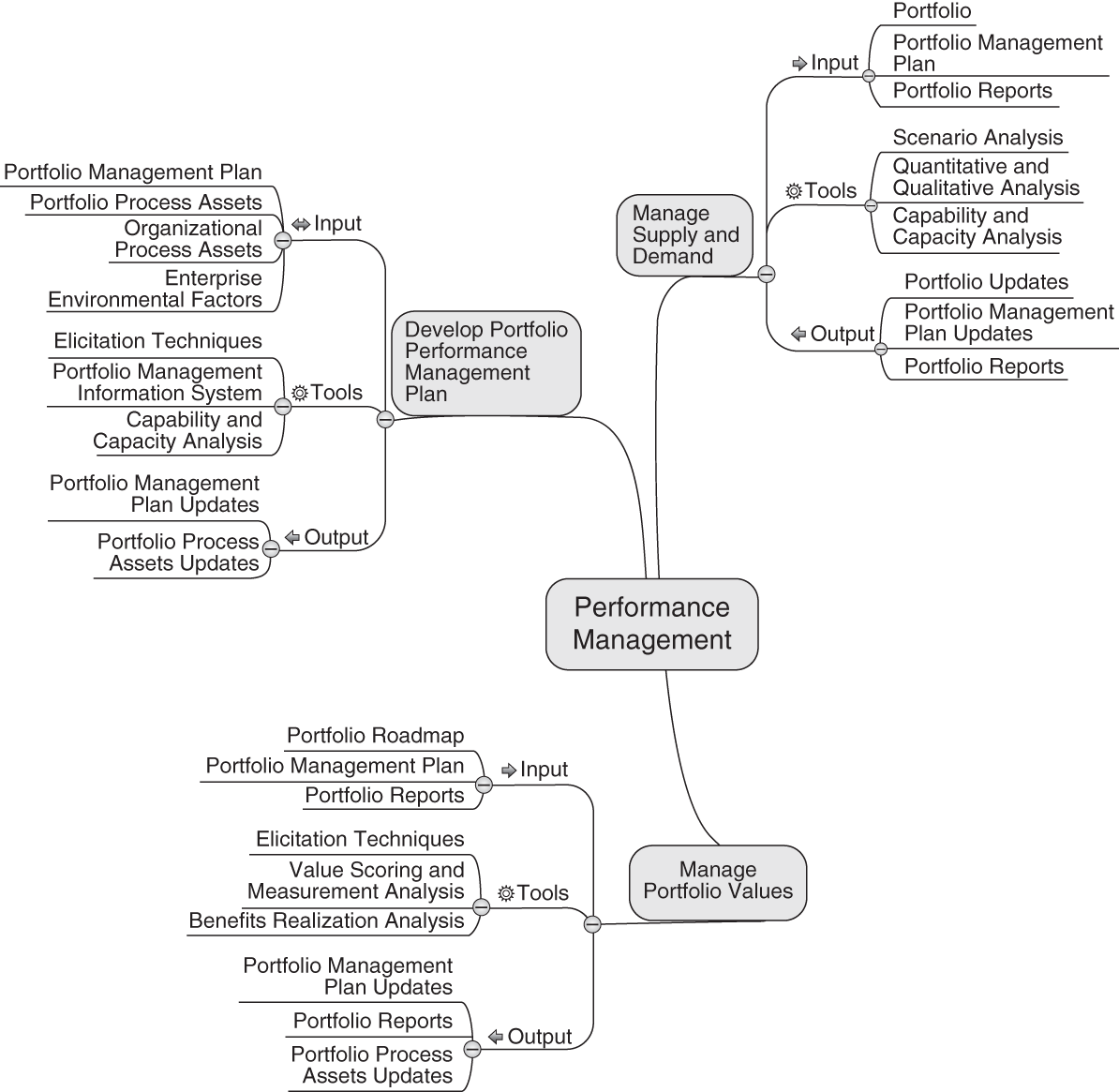
Figure 7.2 Performance management mind map.
“I understand,” I said.
He placed another page in front of me. (See Figure 7.3.)
“You've learned that to measure the project portfolio, you have to have the business drivers, which highlight and define what those business goals are. Then you're going to have KPIs or strategic impact statements that are going to give even further detail. How are we performing against those? It's a different type of measurement. It's not just metrics on time, on budget, on schedule, or even earned value. It's really looking at it from a business perspective, and are we really adding value to the business?
He pointed at the picture with the plane.

Figure 7.3 Implementing performance management.
Credit: Media_Works/Adobe Stock Photos
“Did you know that whenever you fly somewhere, the aircraft that you're flying in is off‐track ninety percent of the time?”
“No, I didn't. But that makes sense,” I replied.
“Most of the trip, the plane is traveling in the wrong direction, even if it's just a few degrees off. Flying is not a straight line. The plane is constantly correcting its flight trajectory so that you end up in LA and not in Canada or in Mexico. The idea is that you can't manage what you don't measure or describe. The majority of the time, our portfolios are going to be off track. So we have to constantly have a process in which we can measure what's happening on a regular, consistent basis just like the computer on the plane, and constantly bring the portfolio back on the track.”
“That makes me feel better because I feel like I've been building sandcastles on the shoreline. As soon as I build it up, the surf takes it down,” I reply.
“That's a great analogy,” said Dr. Richardson. “The focus is on the mission, and the mission is that we're targeting each department and making sure that we understand how to measure the metrics against them. We want to have a strategy with policies and processes, and procedures to focus on that mission and accomplish that mission. You have to have an objective. So you've been talking about getting the musicians more money. That has been your objective, right?”
“Yes.”
“You saw another opportunity for that to happen – musicians playing at a fundraiser. You brought it back to Sam's attention that their main strategy was that the musicians needed to be paid a decent wage. That wasn't a part of your original project of getting them a raise, but it was your overall mission.”
“Ah, I see what you mean,” I replied.
“Metrics should follow a process,” Dr. Richardson continued. “You should have an inventory of metrics that you're going to track, and those metrics should be actionable. In other words, when you see something that's going wrong, you can do something about it. You should be able to make decisions. The metrics should be predictive. They also should have trending metrics, and you should also have metrics that are integrated so that they tell a holistic story about the performance of your portfolio.”
“I made the decision to talk about paying the musicians with Sam because I saw that asking them to play for free was not in alignment with what we were trying to accomplish,” I offered.
“You're getting it,” he replied.
“Portfolio management performance has two types of metrics: tangible and intangible. Your tangible metrics are things that you can physically count, such as the increase in revenue, reduction in headcount or hardware costs, return on investments, a reduction of development costs, reduction in support of service maintenance costs, and reduction in facility costs. Those are things for which you can look in the bank account of the business and see the impact.” (See Figure 7.4.)
“Like the pay increase for the musicians,” I said.
“Yep!” replied Dr. Richardson. “The intangible metrics you need to track are strategic alignment. If you remember from the portfolio analysis view, there is an efficiency frontier view, but there's also a strategic alignment view to show how aligned to the portfolio is the current selection of projects to the prioritized business drivers that we get consensus from the executive team. Also, the degree to which we're mitigating risks – regulatory compliance, sustainability, optimization of human resources, and improvement in customer satisfaction. Many of these are squishy metrics, things that we really can't touch.”
| Tangible | Intangible |
|---|---|
| Increase revenue | Strategic alignment |
| Reduction in head count, hardware or software cost | Degree to which risks have been mitigated |
| Improved return on investment (ROI) | Regulatory compliance |
| Reduced development cost | Sustainability |
| Reduction in support or service maintenance cost | Optimization of human resources |
| Reduction in facilitate cost | Improve customer satisfaction |
Figure 7.4 Portfolio management performance metrics.
“I get it,” I said.
“When it comes to reporting portfolio performance, there are things that you can do around adding decision views, and some of the decision views are ways that you can look at the data. You can look at ROI, your internal rate of return, or net present value. You can look at the strategic impact. Again, that's an intangible one. You can look at the overall cost‐benefit analysis of the portfolio itself and of the selected portfolio. You can have metrics where you can set up parameters to determine how much risk and how much opportunity each project has and then do some mathematics around that. Are you following me?”
“Yes,” I said, making a lot of notes.
“Management views where you're looking at cost versus value. Also, when you can look at resource utilization, availability, capacity, and demand. Do you have any resource bottlenecks? In most organizations, there are few people who are the bottlenecks. Not that that's in a bad way, but what I mean by bottlenecks is that they have such a unique skill set that only maybe one or two people can do what they do, yet their skill set is in high demand, so they become a bottleneck to the business because the business can only go as fast as that resource can go.”
“Fernando,” I said.
“Fernando,” Dr. Richardson repeated. “You either have to hire some additional people who can do what this person does and train them, or we have to figure out a way to streamline the work.”
“But we can't do that with Fernando,” I said.
“True, but some of the things you're asking him to do or need his approval on can be given to someone else. You said he doesn't like to deal with finances, so perhaps those choices should, in a formal way, be given to someone else. But think of this too. There are times that you have guest conductors, right?”
“Yes,” I agreed.
“So there are others who can do his job. Perhaps he should have an assistant. Someone who can deal with getting you the numbers of musicians, ensure that the music is chosen, and other things that are essential to your job.”
“Oh my gosh,” I exclaimed. “You're right. And may God protect their soul as they work with him.”
“It's just a suggestion, and it might not be in your budget, but it is something to consider,” he replied. “Management also focuses on schedule, budget, and quality. Then you have operational views, whether it's processing activities, policies, or procedures. You can have metrics to cover all of those as well as your financial metrics. These are ways that you can begin to measure your tangible metrics as well as your intangible metrics.”
“I like it,” I said.
“In the performance management realm, we also focus on portfolio demand and supply,” he continued. (See Figure 7.5.) “With supply, it's basically looking at resource capacity. What's the capacity of our team, the people, equipment, funding, information, or other assets? What about demand? What's the resource demand? When you look at all those coming through the pipeline, and you look at all the products that are happening, do you have a system in place that you can look across and see the resource demand on those resources and if they have the capacity to handle that, as well as can the business or the customers handle all the change that you are producing?”
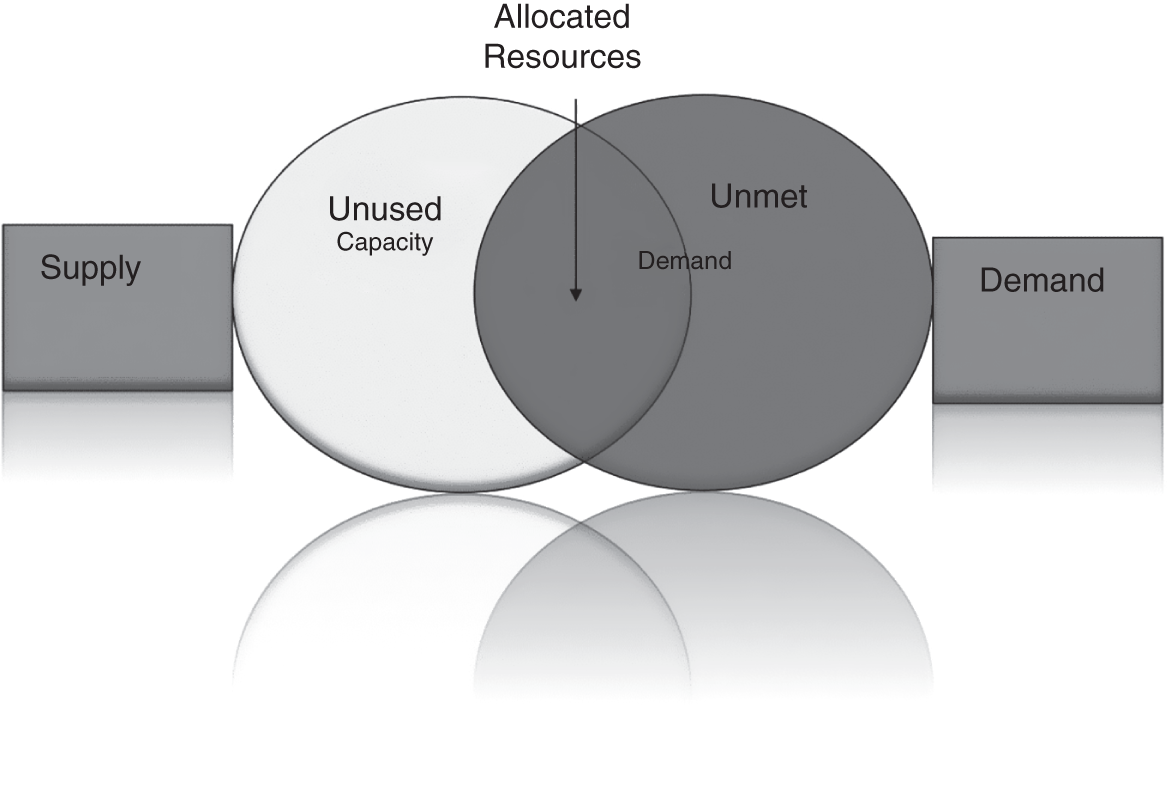
Figure 7.5 Portfolio demand and supply.
“Can you explain that a little further?” I asked.
“Resources should be allocated to minimize both unused capacity and unmet demand. In the area of portfolio performance management, portfolio change management falls within this area, and so in change management, we're looking at things like scope, requirements, scheduling, funding, as well as change, whether it's starting, stopping, or delaying, or reprioritizing a project. It's not changed from the standpoint of additional requirements for this project. That's managing the change that I just talked about earlier. But there's also change control, and it's at the portfolio level, so you have to remember that everything we're talking about is at the portfolio level. Change management is conducted within a controlled, structured environment, and it's facilitated by a change control board.” (See Figure 7.6.)
“Yeah, I have trouble sometimes separating the portfolio aspects from the management parts,” I admitted.
“That will come,” he replied. “You are learning a ton of theory in a short amount of time. It will make more sense as you begin applying it to real‐world situations.”
“If you say so,” I chuckled.

Figure 7.6 Portfolio change management process.
Credit: Digital Storm / Adobe Stock
“The changing board is one of the boards that you would have as part of your governance process. The change control board is responsible for reviewing the impact the change will have on other portfolio components. After managing for a while, you can go to the change board. In your case, your board of directors, since you don't have a separate change board, but they act in that capacity. You'll come with your project and changes to the scope, schedule, or budget of your project.”
“I have already done that,” I said.
“Right. When you go and meet with them, you'll be looking at all of the projects. Is the change that they're requesting on one project having a ripple effect throughout their portfolio and does it cause issues? It also provides the purview to oversee, approve, reject, or reprioritize scheduling our resynchronization of any change requests. So again, we're not talking about change management from the standpoint of a single project. We're talking about change management at the portfolio level. It's a different mindset, skill set, and toolset.”
“So when I bring them new ideas like, say, having more modern stands and stand lights, they would look at that in the larger context of it affecting other things such as the raise I have asked for the musicians.”
“You're getting it,” Dr. Richardson said, as he pointed at the next paper in the stack. (See Figure 7.7.)
“Another area of the project performance management is the portfolio management recalibration. The question to consider when you're thinking about portfolio recalibration is what is the best set of projects given the current budget and available resource capacity? Because the whole idea about calibration is that you're basically looking to reorganize or to take what you have and shake it up and look to see if you can optimize it anymore, especially if there are changes being introduced that could impact the portfolio or if there are external changes to the business environment that you have to consider, such as how to take care of a regulation and compliance project. How's that going to impact transforming the business project or growing the business project compared to our run‐the‐business project, which is just keeping the lights on in the business?”
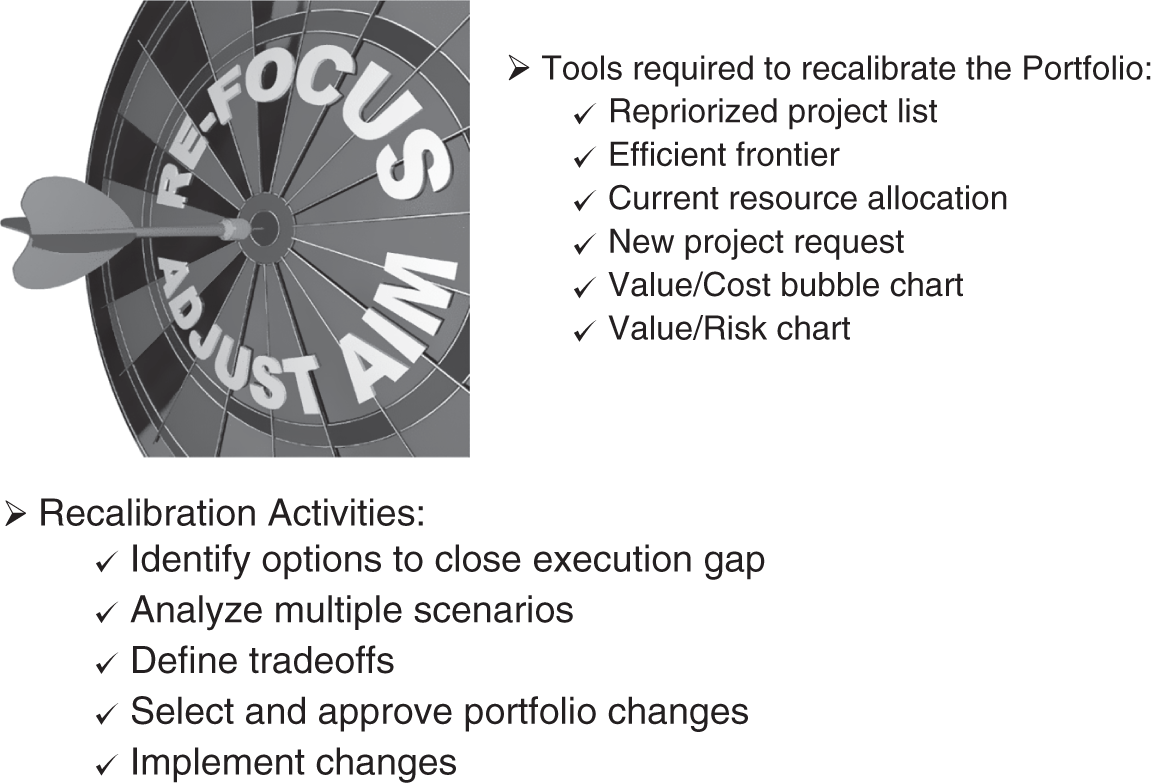
Figure 7.7 Portfolio management recalibration.
I nodded.
“Something else we need to think about is whether you are getting the best from the projects in your portfolio. Are you getting the greatest return? Are they getting done quickly so that the business can receive the value that the project is going to deliver? Are you overinvesting in the portfolio? Because sometimes you can overinvest.”
“Let's talk about the efficiency frontier. Organizations that use the efficiency frontier methodology are able to reduce waste and increase value creation by twenty to forty percent.” (See Figure 7.8.)
“Wow,” I exclaimed.
“The idea around efficiency frontier is where it says the optimal portfolio. A portfolio is optimal because the curve leading up to that portfolio is at its steepest. The trajectory is getting more bang for your buck. After that arrow where it says optimal, there's a little bit of bump‐up. It's going up slowly but, from a risk standpoint and a cost standpoint, you're actually spending much more money to get that little bit of additional increase compared to the initial jump where you're at this arc up to the optimal portfolio. That's the idea of optimization. Should I invest additional funds for higher‐risk and higher‐return types of projects where I'm getting very little return on that additional investment, or should I keep the portfolio at this optimal portfolio area along the efficiency frontier curve?”
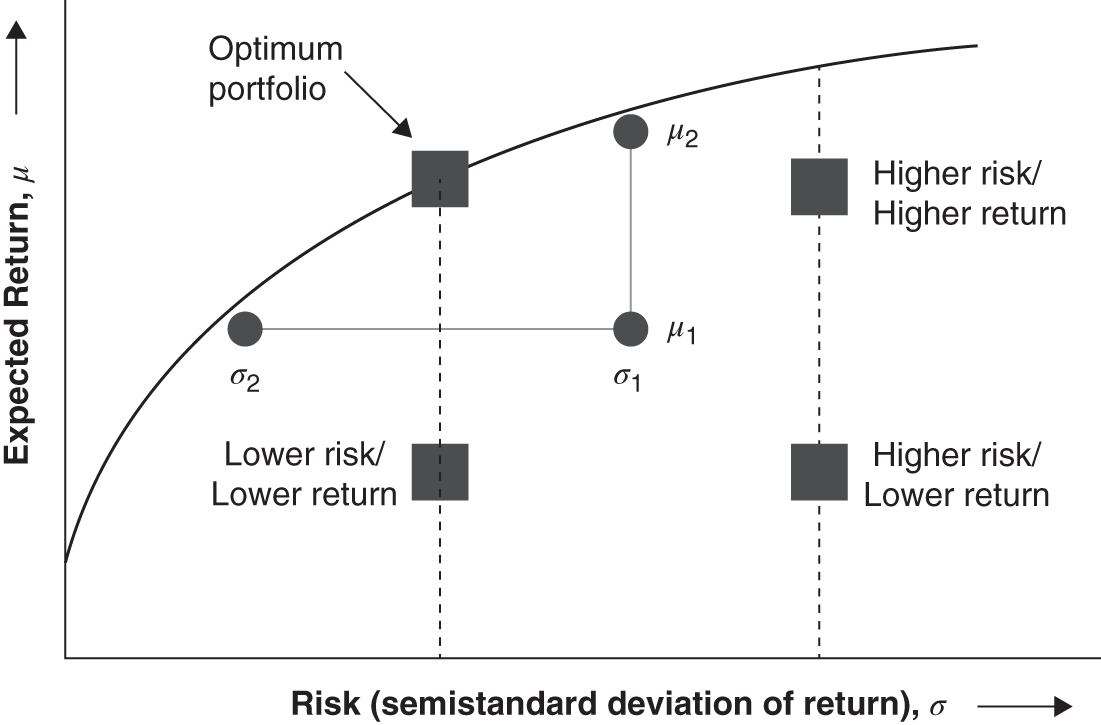
Figure 7.8 Portfolio efficiency frontier.
As I jotted down notes, I thought about the current projects in my portfolio and wondered what that optimum point would be.
“This is all based on algorithms, and there are systems that can do that,” Dr. Richardson continued. “The main takeaway I want you to think about is an optimal portfolio that offers the highest expected return from a defined level of risk or the lowest risk for a given level of expected return. Portfolios that lie below the efficiency frontier are suboptimal. The ones that are way at the bottom, they're suboptimal.”
“I hope my portfolio is not in those areas,” I commented.
“I don't think it is, and besides, you're just starting out. This process is ongoing and one that you will need to monitor. If your portfolio falls into those suboptimal areas, you're not getting the greatest value for the money that you're spending because you don't have enough return for the level of risk. Portfolios that are at the right of the efficiency frontier are also suboptimal. In other words, the ones where it's a high risk, low return, high risk, high return because they have a high level of risk for a defined rate of return. The efficiency frontier allows you to understand the value that is destroyed by each constraint or by adding additional projects. That's why when you manage way too many projects, you may be killing your ability to gain value from those projects.”
“Since you've had me prioritize my portfolio, I have significantly cut down the number of overlapping projects at one time,” I said.
“Yes, and you will be thankful you did,” he replied.
“Another way to manage portfolio management value is the portfolio variance report, the benefits realization plan, and the value scoring and measurements,” he continued. (See Figure 7.9.) “According to the Standard for Portfolio Management, the third edition from the Project Manager Institute, the portfolio value is defined as the aggregated value delivered by the portfolio components, and the components are projects, programs, and sub‐portfolios. The goal is to deliver the maximum value possible aligned with strategic objectives and with an acceptable level of risk based on the risk tolerance of the organization. These are three types of reports that you can use to help you measure and manage your portfolio value. It's the portfolio variance report, the benefits realization plan, and the value scoring and measurement documentation.”
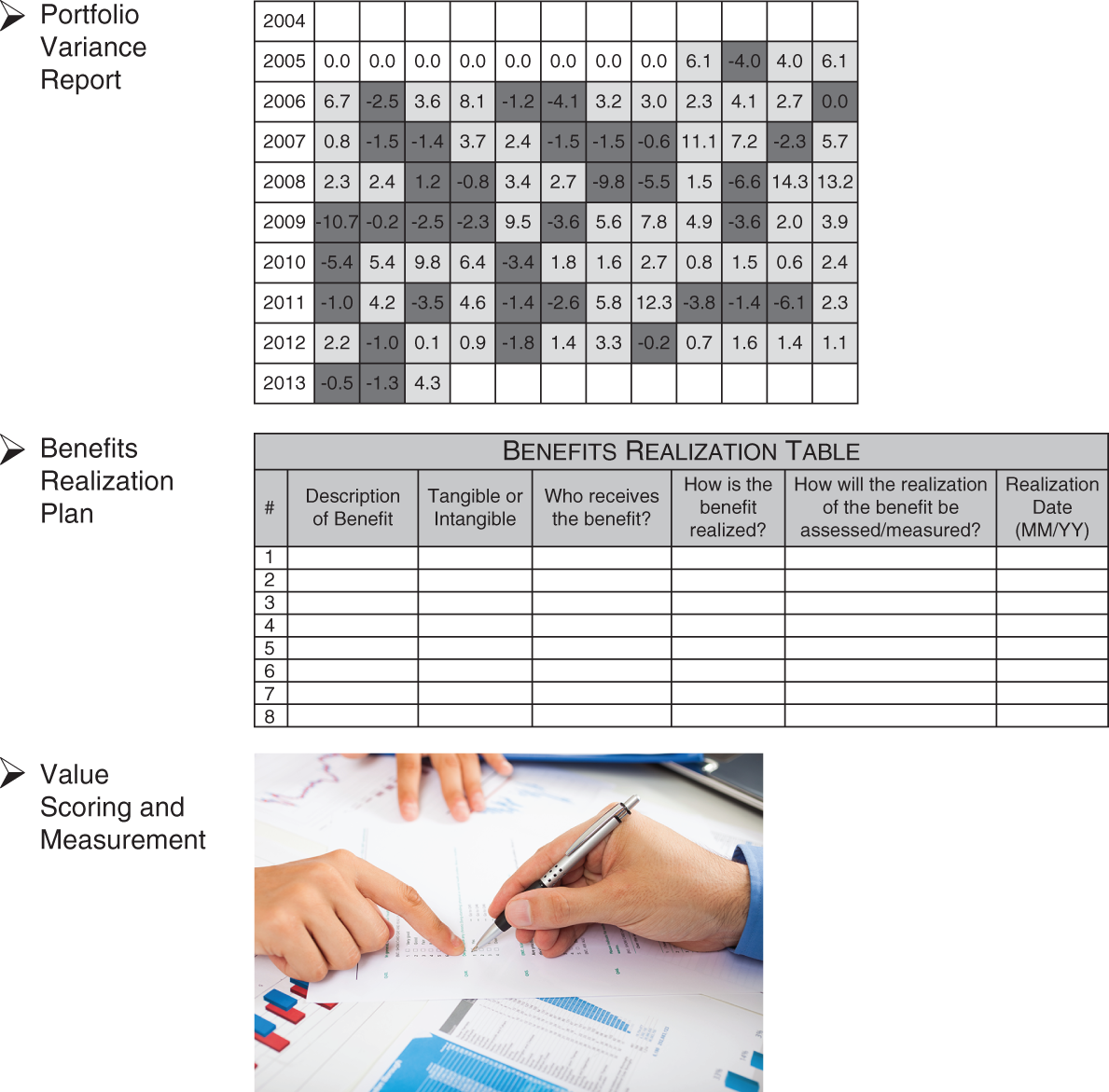
Figure 7.9 Portfolio management value.
Credit: Minerva Studio / Adobe Stock
As I looked at the next page (see Figure 7.10), Dr. Richardson said, “Here's some guidance on establishing portfolio manager reporting schedules and activities. Suppose you can pull the leadership team together to go through the reports on a monthly basis. You're looking for reports that are going to provide insight into past performance, and you're also going to look for reports that are going to provide forecasting of your expected results. In other words, those ones where it shows the portfolio value is optimized for the portfolio and is strategically aligned, or a cost versus value type of report. Also, you should include variance and variance analysis, its recommendations, and areas to be addressed. When you go to one of those, you should come prepared. It takes time for you to analyze the portfolio. When you're managing projects, your project reports are about how many hours did we use, are we on time, on budget, on schedule, are we under budget, are we meeting the requirements? Portfolio management requires a different set of skills.”
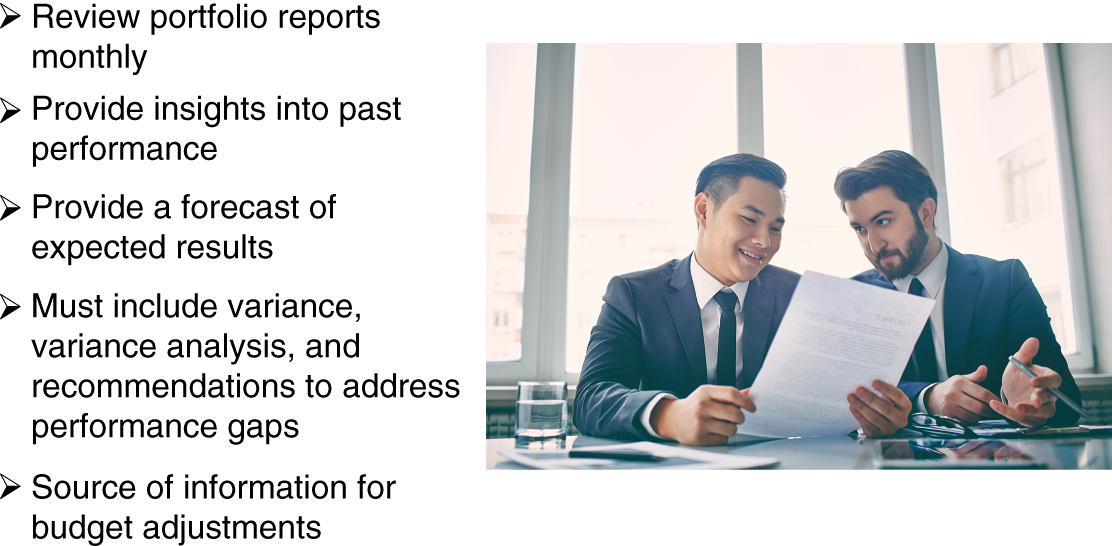
Figure 7.10 Establish portfolio management reporting.
Credit: pressmaster / Adobe Stock
“I'm beginning to understand that,” I said.
“It's a different mindset. Now you're thinking about the variances of managing the overall portfolio, which is impacting the performance of the business.”
“That is a lot,” I said with a sigh.
“It is, but you are already doing some of this stuff from an instinctual level. I hope this will help you refine the process.”
“It has been helpful,” I said.
“Listen, I know this thing with your wife is weighing heavy on you,” Dr. Richardson said as he placed a hand on my shoulder. “Pace yourself and take care of yourself. If you need to talk, please call me anytime. And I want to offer you again, if you need to pause our meetings for a while, we can.”
“I think keeping as normal a life as possible will help me the most. I do appreciate everything, though.”
“My pleasure,” said Dr. Richardson as he left.
I sighed and scooped up my papers. It was time to go home and wait for the kids and the conversation I dreaded the most.
Dr. Richardson's Tips
- According to the Standard for Portfolio Management by the Project Manager Institute, portfolio performance management is the systematic planning, measuring, and monitoring of the portfolio's value, and organizational value, through achievement of the organization's strategic goals. Basically, we're measuring how we are performing against the strategic goals. We're not looking at performance from the standpoint of on time, on budget, or on schedule, as a project manager would. We're actually looking at the performance of how the portfolio is performing against being aligned to the strategic goals.
- Another area of the project performance management is the portfolio management recalibration. The question to consider when you're thinking about portfolio recalibration is: What is the best set of projects given the current budget and available resource capacity? Because the whole idea about calibration is you're basically looking to reorganize or to take what you have and shake it up and look to see if you can optimize it anymore.
- Another way to manage portfolio management value is the portfolio variance report, the benefits realization plan, and the value scoring and measurements. According to the Standard for Portfolio Management, the third edition from the Project Manager Institute, the portfolio value is defined as the aggregated value delivered by the portfolio components, and the components are projects, programs, and sub‐portfolios. The goal is to deliver the maximum value possible aligned with strategic objectives and with an acceptable level of risk based on the risk tolerance of the organization.
